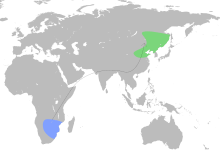Amur falcon
| Amur falcon | |
|---|---|
 |
|
| Male | |
 |
|
| Female | |
| Scientific classification | |
| Kingdom: | Animalia |
| Phylum: | Chordata |
| Class: | Aves |
| Order: | Falconiformes |
| Family: | Falconidae |
| Genus: | Falco |
| Species: | F. amurensis |
| Binomial name | |
|
Falco amurensis Radde, 1863 |
|
 |
|
|
Breeding Non-breeding |
|
| Synonyms | |
|
|
| Measurements | |||
|---|---|---|---|
| Length | 275–290 mm (10.8–11.4 in) | ||
| 285–300 mm (11.2–11.8 in) | |||
| Tail | 123–130 mm (4.8–5.1 in) | ||
| 129–132 mm (5.1–5.2 in) | |||
| Head | 41–43 mm (1.6–1.7 in) | ||
| 42–44 mm (1.7–1.7 in) | |||
| Tarsus | 60–62 mm (2.4–2.4 in) | ||
| 65–67 mm (2.6–2.6 in) | |||
| Weight | 97–155 g (3.4–5.5 oz) | ||
| 111–188 g (3.9–6.6 oz) | |||
The Amur falcon (Falco amurensis) is a small raptor of the falcon family. It breeds in south-eastern Siberia and Northern China before migrating in large flocks across India and over the Arabian Sea to winter in Southern Africa. It was earlier treated as a subspecies of the red-footed falcon (Falco vespertinus) and known as the eastern red-footed falcon. Males are dark grey with reddish brown thighs and undertail coverts; reddish orange eye-ring, cere, and feet. Females are duller above, with dark scaly markings on white underparts, an orange eye ring, cere, and legs. Only a pale wash of rufous is visible on their thighs and undertail coverts. Their diet consists mainly of insects, such as termites; during migration over the sea, they are thought to feed on migrating dragonflies. The route that they take from Africa back to their breeding grounds is as yet unclear.
Males are characteristically dark sooty grey above with rufous thighs and vent. In flight, the wing lining is white, contrasting with the dark wing feathers. Adult males of the closely related red-footed falcon have a dark grey wing lining. In Africa, males can be confused with melanistic Gabar goshawks, but the chestnut on the vent is distinctive. Also, there may be some superficial resemblance to the sooty falcon and the grey kestrel, but those two species both have yellow feet and cere. The wings are long as in most falcons (with a span of 63–71 cm) and at rest the wing tip reaches or extends just beyond the tail-tip.
Females can be more difficult to identify as they share a pattern common to many falcons, but are distinctive in having an orange eye-ring, a red cere and reddish orange feet. Juveniles can be confused only with those of the red-footed falcon, but lack the buffy underwing coverts.
The Amur falcon was long considered a subspecies or morph of the red-footed falcon, but it is nowadays considered distinct. Nonetheless, it is the red-footed falcon's closest relative; their relationship to other falcons is more enigmatic. They appear morphologically somewhat intermediate between kestrels and hobbies and DNA sequence data has been unable to further resolve this question, mainly due to lack of comprehensive sampling.
...
Wikipedia

